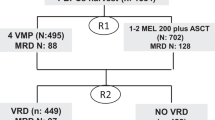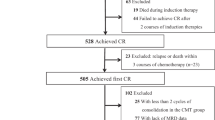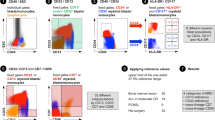Abstract
The potential impact on patient outcome of different Minimal residual disease (MRD) levels at time of transplant in patients with lymphoblastic leukemia undergoing allogeneic hematopoietic SCT (HSCT) remains uncertain. In this study, we quantified MRD levels at time of transplant using multiparameter flow cytometry (MFC). Mononuclear cells from marrow aspirates were obtained from 102 adult and child patients before their conditioning regimen. Quantification of MRD levels was carried out by detecting patient-specific leukemia-associated immunophenotypes using four-color MFC. Thirty patients exhibited measurable levels of MRD at the time of transplant, with low levels (0.01 to ⩽0.1%) in 12 cases, intermediate levels (>0.1 to ⩽1%) in 8 cases and high levels (>1%) in 10 cases. The leukemia-free survival (LFS) rates were 65.9±7.0%, 42.9±15.7% and 0% for negative, low levels ⩽0.1% and intermediate-high levels >0.1%, respectively (P<0.001, log-rank test). Overall survival (OS) was 52.3±7.6%, 28.6±13.8% and 0% for MRD-negative, low levels ⩽0.1% and intermediate-high levels >0.1%, respectively (P<0.001, log-rank test). Multivariate Cox analysis confirmed that detection of leukemia cells by flow cytometry at transplant was the most significantly adverse factor for OS, LFS and EFS after transplant.
This is a preview of subscription content, access via your institution
Access options
Subscribe to this journal
Receive 12 print issues and online access
$259.00 per year
only $21.58 per issue
Buy this article
- Purchase on Springer Link
- Instant access to full article PDF
Prices may be subject to local taxes which are calculated during checkout



Similar content being viewed by others
References
Pui CH, Robison LL, Look AT . Acute lymphoblastic leukaemia. Lancet 2008; 371: 1030–1043.
Smith AR, Baker KS, Defor TE, Verneris MR, Wagner JE, Macmillan ML . Hematopoietic cell transplantation for children with acute lymphoblastic leukemia in second complete remission: similar outcomes in recipients of unrelated marrow and umbilical cord blood versus marrow from HLA matched sibling donors. Biol Blood Marrow Transplant 2009; 15: 1086–1093.
Tomblyn MB, Arora M, Baker KS, Blazar BR, Brunstein CG, Burns LJ et al. Myeloablative hematopoyetic cell transplantation for acute lymphoblastic leukaemia: analysis of graft sources and long-term outcomes. J Clin Oncol 2009; 27: 3634–3641.
Ferra C, Sanz J, de la Camara R, Sanz G, Bermudez A, Valcarcel D et al. Unrelated transplantation for poor-prognosis adult acute lymphoblastic leukemia: long-term outcome analysis and study of the impact of hematopoietic graft source. Biol Blood Marrow Transplant 2010; 16: 957–966.
Kiehl MG, Kraut L, Schwerdtfeger R, Hertenstein B, Remberger M, Kroeger N et al. Outcome of allogeneic hematopoietic stem-cell transplantation in adult patients with acute lymphoblastic leukemia: no difference in related compared with unrelated transplant in first complete remission. J Clin Oncol 2004; 22: 2816–2825.
Goldstone AH, Richards SM, Lazarus HM, Tallman MS, Buck G, Fielding AK et al. In adults with standard-risk acute lymphoblastic leukemia, the greatest benefit is achieved from a matched sibling allogeneic transplantation in first complete remission, and an autologous transplantation is less effective than conventional consolidation/maintenance chemotherapy in all patients: final results of the International ALL Trial (MRC UKALL XII/ECOG E2993). Blood 2008; 111: 1827–1833.
Lee S, Cho BS, Kim SY, Choi SM, Lee DG, Eom KS et al. Allogeneic stem cell transplantation in first complete remission enhances graft-versus-leukemia effect in adults with acute lymphoblastic leukemia: antileukemic activity of chronic graft-versus-host disease. Biol Blood Marrow Transplant 2007; 13: 1083–1094.
Coustan-Smith E, Sancho J, Hancock ML, Boyett JM, Behm FG, Raimondi SC et al. Clinical importance of minimal residual disease in childhood acute lymphoblastic leukemia. Blood 2000; 96: 2691–2696.
Vidriales MB, Pérez JJ, López-Berges MC, Gutiérrez N, Ciudad J, Lucio P et al. Minimal residual disease in adolescent (older than 14 years) and adult acute lymphoblastic leukemias: early immunophenotypic evaluation has high clinical value. Blood 2003; 101: 4695–4700.
Campana D . Minimal residual disease in acute lymphoblastic leukemia. Hematology Am Soc Hematol Educ Program 2010; 2010: 7–12.
Sramkova L, Muzikova K, Fronkova E, Krejci O, Sedlacek P, Formankova R et al. Detectable minimal residual disease before allogeneic hematopoietic stem cell transplantation predicts extremely poor prognosis in children with acute lymphoblastic leukemia. Pediatr Blood Cancer 2007; 48: 93–100.
Krejci O, van der Velden VH, Bader P, Kreyenberg H, Goulden N, Hancock J et al. Level of minimal residual disease prior to haematopoietic stem cell transplantation predicts prognosis in paediatric patients with acute lymphoblastic leukaemia: a report of the Pre-BMT MRD Study Group. Bone Marrow Transplant 2003; 32: 849–851.
Goulden N, Bader P, Van Der Velden V, Moppett J, Schilham M, Masden HO et al. Minimal residual disease prior to stem cell transplant for childhood acute lymphoblastic leukaemia. Br J Haematol 2003; 122: 24–29.
Bader P, Hancock J, Kreyenberg H, Goulden NJ, Niethammer D, Oakhill A et al. Minimal residual disease (MRD) status prior to allogeneic stem cell transplantation is a powerful predictor for post-transplant outcome in children with ALL. Leukemia 2002; 16: 1668–1672.
Knechtli CJ, Goulden NJ, Hancock JP, Grandage VL, Harris EL, Garland RJ et al. Minimal residual disease status before allogeneic bone marrow transplantation is an important determinant of successful outcome for children and adolescents with acute lymphoblastic leukemia. Blood 1998; 92: 4072–4079.
Van der Velden VH, Joosten SA, Willemse MJ, van Wering ER, Lankester AW, van Dongen JJ et al. Real-time quantitative PCR for detection of minimal residual disease before allogeneic stem cell transplantation predicts outcome in children with acute lymphoblastic leukemia. Leukemia 2001; 15: 1485–1487.
Uzunel M, Mattsson J, Jaksch M, Remberger M, Ringdén O . The significance of graft-versus-host disease and pretransplantation minimal residual disease status to outcome after allogeneic stem cell transplantation in patients with acute lymphoblastic leukemia. Blood 2001; 98: 1982–1984.
Bader P, Kreyenberg H, Henze GH, Eckert C, Reising M, Willasch A et al. Prognostic value of minimal residual disease quantification before allogeneic stem-cell transplantation in relapsed childhood acute lymphoblastic leukemia: the ALL-REZ BFM Study Group. J Clin Oncol 2009; 27: 377–384.
Leung W, Campana D, Yang J, Pei D, Coustan-Smith E, Gan K et al. High success of hematopoietic cell transplantation regardless of donor source in children with very high-risk leukemia. Blood 2011; 118: 223–230.
Elorza I, Palacio C, Dapena JL, Gallur L, de Toledo JS, de Heredia CD . Relationship between minimal residual disease measured by multiparametric flow cytometry prior to allogeneic hematopoietic stem cell transplantation and outcome in children with acute lymphoblastic leukemia. Haematologica 2010; 95: 936–941.
Foster JH, Hawkins DS, Loken MR, Wells DA, Thomson B . Minimal residual disease detected prior to hematopoietic cell transplantation. Pediatr Blood Cancer 2011; 57: 163–165.
Doney K, Gooley TA, Deeg HJ, Flowers ME, Storb R, Appelbaum FR . Allogeneic hematopoietic cell transplantation with full-intensity conditioning for adult acute lymphoblastic leukemia: results from a single center, 1998–2006. Biol Blood Marrow Transplant 2011; 17: 87–95.
Sanchez J, Serrano J, Gomez P, Martinez F, Martin C, Madero L et al. Clinical value of immunological monitoring of minimal residual disease in acute lymphoblastic leukaemia after allogeneic transplantation. Br J Haematol 2002; 116: 686–694.
Sanchez-Garcia J, Serrano J, Gomez P, Martinez F, Martin C, Roman-Gomez J et al. The impact of acute and chronic graft-versus-host disease on normal and malignant B-lymphoid precursors after allogeneic stem cell transplantation for B-lineage acute lymphoblastic leukemia. Haematologica 2006; 91: 340–347.
Spinelli O, Peruta B, Tosi M, Guerini V, Salvi A, Zanotti MC et al. Clearance of minimal residual disease after allogeneic stem cell transplantation and the prediction of the clinical outcome of adult patients with high-risk acute lymphoblastic leukemia. Haematologica 2007; 92: 612–618.
Coustan-Smith E, Campana D . Immunologic minimal residual disease detection in acute lymphoblastic leukemia: a comparative approach to molecular testing. Best Pract Res Clin Haematol 2010; 23: 347–358.
Dworzak MN, Gaipa G, Ratei R, Veltroni M, Schumich A, Maglia O et al. Standardization of flow cytometric minimal residual disease evaluation in acute lymphoblastic leukemia: Multicentric assessment is feasible. Cytometry B Clin Cytom 2008; 74: 331–340.
Coustan-Smith E, Song G, Clark C, Key L, Liu P, Mehrpooya M et al. New markers for minimal residual disease detection in acute lymphoblastic leukemia. Blood 2011; 117: 6267–6276.
Topp MS, Kufer P, Gökbuget N, Goebeler M, Klinger M, Neumann S et al. Targeted therapy with the T-cell-engaging antibody blinatumomab of chemotherapy-refractory minimal residual disease in B-lineage acute lymphoblastic leukemia patients results in high response rate and prolonged leukemia-free survival. J Clin Oncol 2011; 29: 2493–2498.
Pulsipher MA, Bader P, Klingebiel T, Cooper LJ . Allogeneic transplantation for pediatric acute lymphoblastic leukemia: the emerging role of peritransplantation minimal residual disease/chimerism monitoring and novel chemotherapeutic, molecular, and immune approaches aimed at preventing relapse. Biol Blood Marrow Transplant 2009; 15 (S1): 62–71.
Bader P, Kreyenberg H, Hoelle W, Dueckers G, Handgretinger R, Lang P et al. Increasing mixed chimerism is an important prognostic factor for unfavorable outcome in children with acute lymphoblastic leukemia after allogeneic stem-cell transplantation: possible role for pre-emptive immunotherapy? J Clin Oncol 2004; 22: 1696–1705.
Weber G, Karbach J, Kuçi S, Kreyenberg H, Willasch A, Koscielniak E et al. WT1 peptide-specific T cells generated from peripheral blood of healthy donors: possible implications for adoptive immunotherapy after allogeneic stem cell transplantation. Leukemia 2009; 23: 1634–1642.
Acknowledgements
This study was supported by a grant from Ministerio de Ciencia e Innovacion BFU2009-11826, by Asociacion Medicina e Investigación (AMI) and by a donation form ‘Instituto Roche para las soluciones Integrales en Salud’. J Serrano-Lopez has a fellowship from Spanish Foundation of Hematology and Hemotherapy (FEHH) and Fundación Reina Sofía de Córdoba.
Author contributions: JS-G, JSL and AT-G designed the study. JS-G, JS-L and JMG-C performed cytometric assays. PG-G, FM, RR, CM, AR-V, JRM-H and JC collected patient samples and clinical data. JS-G, JSL and MAA performed statistical analyses and interpreted data. JS-G wrote the manuscript. All authors critically reviewed the manuscript and gave their final approval. JS-G is responsible of figures and tables.
Author information
Authors and Affiliations
Corresponding author
Ethics declarations
Competing interests
The authors declare no conflict of interest.
Additional information
Supplementary Information accompanies the paper on Bone Marrow Transplantation website
Supplementary information
Rights and permissions
About this article
Cite this article
Sanchez-Garcia, J., Serrano, J., Serrano-Lopez, J. et al. Quantification of minimal residual disease levels by flow cytometry at time of transplant predicts outcome after myeloablative allogeneic transplantation in ALL. Bone Marrow Transplant 48, 396–402 (2013). https://doi.org/10.1038/bmt.2012.147
Received:
Revised:
Accepted:
Published:
Issue Date:
DOI: https://doi.org/10.1038/bmt.2012.147
Keywords
This article is cited by
-
The differential effect of disease status at allogeneic hematopoietic cell transplantation on outcomes in acute myeloid and lymphoblastic leukemia
Annals of Hematology (2021)
-
Influence of pre-transplant minimal residual disease on prognosis after Allo-SCT for patients with acute lymphoblastic leukemia: systematic review and meta-analysis
BMC Cancer (2018)
-
Testing for minimal residual disease in adults with acute lymphoblastic leukemia in Europe: a clinician survey
BMC Cancer (2018)
-
Hematopoietic Stem Cell Transplantation for Adult Philadelphia-Negative Acute Lymphoblastic Leukemia in the First Complete Remission in the Era of Minimal Residual Disease
Current Oncology Reports (2018)



